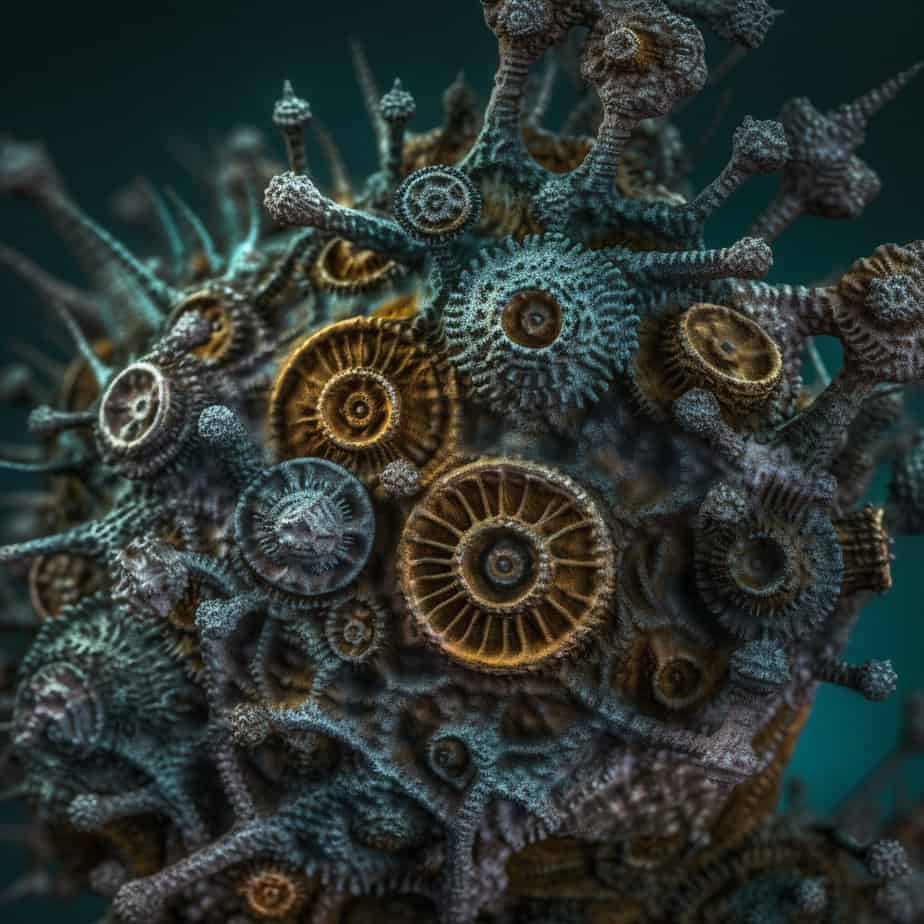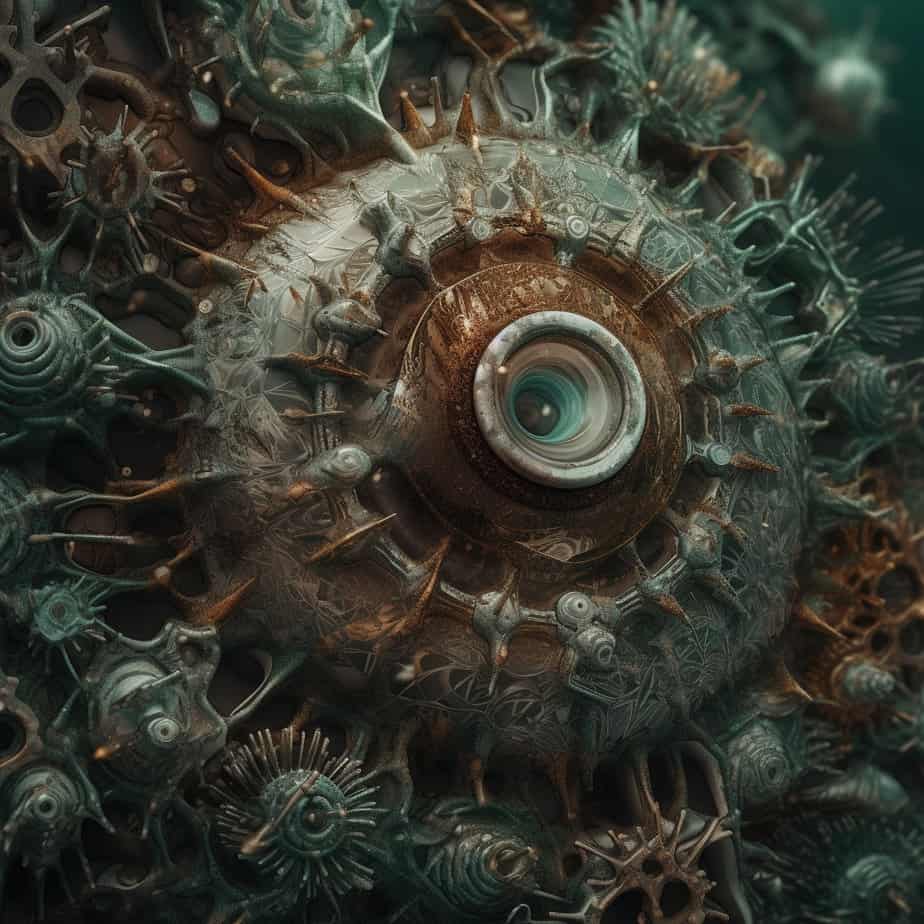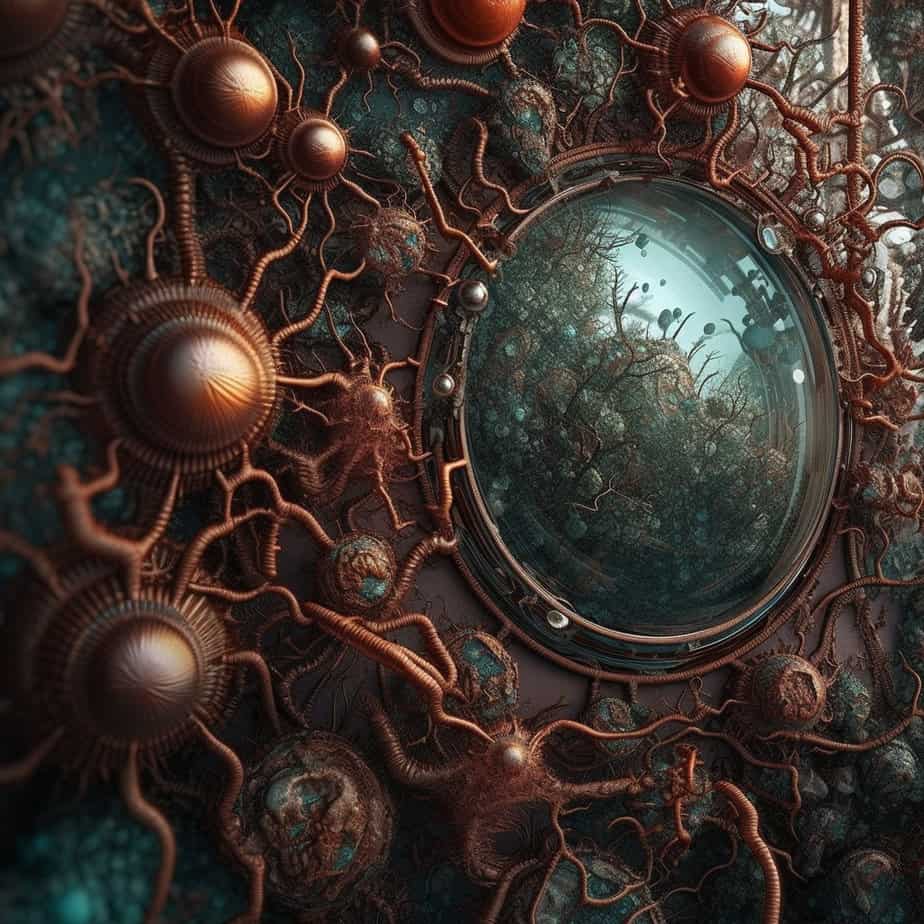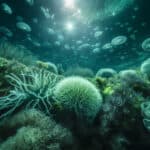Iron and phytoplankton are two interconnected elements in the marine ecosystem that play a crucial role in maintaining the health and balance of our oceans. Phytoplankton, microscopic plant-like organisms, are responsible for approximately half of the Earth’s oxygen production through photosynthesis. These tiny organisms form the foundation of the marine food web, providing sustenance for zooplankton, fish, and other marine creatures. However, the growth and productivity of phytoplankton are heavily dependent on the availability of iron, an essential micronutrient. Iron acts as a catalyst for photosynthesis, enabling phytoplankton to convert carbon dioxide and sunlight into organic matter. In this article, we will explore the intricate relationship between iron and phytoplankton, and the significance of this relationship for the overall health of our oceans.
Key Takeaways
- Iron is an essential micronutrient for phytoplankton growth and productivity in the ocean.
- Iron limitation can significantly impact phytoplankton populations and the overall marine ecosystem.
- Understanding iron dynamics and its availability is crucial for predicting and managing phytoplankton blooms and carbon cycling in the ocean.
- Human activities, such as pollution and climate change, can affect iron availability and have implications for phytoplankton and marine ecosystems.
Understanding Phytoplankton: The Tiny Powerhouses

A. What is Phytoplankton and Why is it Important?
Phytoplankton are microscopic, plant-like organisms that live in aquatic environments, particularly in the ocean. These tiny organisms play a crucial role in the marine ecosystem and have a significant impact on the health of our planet.
Phytoplankton are responsible for approximately half of the world’s oxygen production. Through the process of photosynthesis, they convert carbon dioxide into oxygen, helping to regulate the Earth’s atmospheric composition. This makes them vital for the survival of all living organisms, including humans.
Additionally, phytoplankton are at the base of the marine food chain. They serve as a primary food source for many marine animals, such as zooplankton, small fish, and even whales. Without phytoplankton, the entire marine food web would collapse, leading to a devastating impact on marine life.
B. The Role of Phytoplankton in Marine Ecosystems
Phytoplankton play a crucial role in maintaining the balance of marine ecosystems. They are responsible for nutrient cycling, which involves the uptake and recycling of essential elements like nitrogen, phosphorus, and iron. These nutrients are essential for the growth and survival of phytoplankton, as well as other marine organisms.
Iron, in particular, is a critical nutrient for phytoplankton growth. It acts as a catalyst in the production of chlorophyll, the pigment that enables photosynthesis. However, iron is often limited in the ocean, especially in areas far from land. This limitation restricts phytoplankton growth and productivity.
Iron fertilization is a process that involves adding iron to iron-deficient waters to stimulate phytoplankton growth. This method has been studied as a potential means to enhance carbon dioxide absorption from the atmosphere and mitigate climate change. By promoting phytoplankton growth, iron fertilization can increase the ocean’s productivity and enhance the biological pump, which is the process by which carbon is transported from the surface to the deep ocean.
C. Phytoplankton and Humans: An Unseen Connection
Although phytoplankton may seem distant from our daily lives, they have a significant impact on human well-being. Their ability to absorb carbon dioxide helps regulate the Earth’s climate, making them an important player in the fight against global warming.
Furthermore, phytoplankton indirectly support the fishing industry and provide a source of food for many coastal communities. Healthy phytoplankton populations contribute to the abundance of fish and other seafood, sustaining livelihoods and ensuring food security for millions of people worldwide.
However, human activities, such as pollution and climate change, pose a threat to phytoplankton populations. Rising sea temperatures, ocean acidification, and nutrient imbalances can disrupt the delicate balance of marine ecosystems, leading to harmful algal blooms and the decline of phytoplankton.
To protect and preserve phytoplankton, it is crucial to address these environmental challenges. Sustainable practices, such as reducing carbon emissions and minimizing pollution, can help maintain the health of our oceans and ensure the continued functioning of these tiny powerhouses.
In conclusion, phytoplankton are essential organisms that play a vital role in our planet‘s health. From producing oxygen to supporting marine ecosystems and indirectly benefiting human well-being, their significance cannot be overstated. By understanding and safeguarding these tiny powerhouses, we can contribute to the preservation of our oceans and the overall well-being of our planet.
The Intricacies of Phytoplankton Production
Phytoplankton, the microscopic plants that inhabit the world’s oceans, play a crucial role in maintaining the delicate balance of marine ecosystems. These tiny organisms are responsible for approximately half of the Earth’s oxygen production and serve as the foundation of the marine food web. In this section, we will explore the fascinating process of phytoplankton production, the art of cultivating them, and the differences between phytoplankton and zooplankton.
A. How is Phytoplankton Made?
Phytoplankton production is a complex process that relies on a variety of factors, including sunlight, nutrients, and trace metals. Like all plants, phytoplankton undergo photosynthesis, a process that converts sunlight, carbon dioxide, and water into energy-rich organic compounds. However, unlike terrestrial plants, phytoplankton are not rooted in the ground and can freely float in the ocean.
To thrive, phytoplankton require an adequate supply of nutrients, such as nitrogen, phosphorus, and iron. Iron, in particular, is a crucial micronutrient that can limit phytoplankton growth in many regions of the ocean. Iron deficiency can severely impact the production of chlorophyll, the pigment responsible for capturing sunlight during photosynthesis.
Iron enters the ocean through various sources, including atmospheric dust deposition, river runoff, and hydrothermal vents. Once in the water, iron undergoes a series of chemical reactions that determine its solubility and availability to phytoplankton. Iron-rich waters can promote phytoplankton growth and lead to the formation of vibrant algal blooms.
B. The Art of Cultivating Phytoplankton: A How-To Guide
Cultivating phytoplankton in a controlled environment can be a challenging but rewarding endeavor. Whether for scientific research or aquaculture purposes, following certain guidelines can help ensure successful cultivation.
-
Selecting the right species: Different species of phytoplankton have varying requirements for light, temperature, and nutrients. Choose a species that suits your specific needs and environmental conditions.
-
Providing optimal conditions: Phytoplankton thrive in well-lit environments with a consistent light-dark cycle. Maintain suitable water temperature and salinity levels to mimic natural conditions.
-
Nutrient supplementation: Supply phytoplankton with the necessary nutrients, including nitrogen, phosphorus, and trace metals. Iron supplementation, in particular, can enhance growth in iron-limited regions.
-
Monitoring and adjusting: Regularly monitor water quality parameters such as pH, dissolved oxygen, and nutrient concentrations. Adjust these parameters as needed to maintain optimal conditions for phytoplankton growth.
-
Harvesting and maintaining cultures: When the phytoplankton cultures reach their desired density, carefully harvest them using appropriate techniques. Maintain cultures by providing fresh nutrients and removing waste products.
C. The Difference Between Phytoplankton and Zooplankton
While both phytoplankton and zooplankton are important components of marine ecosystems, they differ in their ecological roles and characteristics.
-
Primary producers vs. consumers: Phytoplankton are primary producers, meaning they convert sunlight and nutrients into organic matter through photosynthesis. Zooplankton, on the other hand, are consumers that feed on phytoplankton and other small organisms.
-
Size and mobility: Phytoplankton are microscopic and float freely in the water column, relying on ocean currents for movement. Zooplankton, in contrast, can range in size from microscopic to several centimeters and exhibit various forms of mobility, including swimming and drifting.
-
Ecological impact: Phytoplankton are vital for carbon dioxide absorption and play a significant role in the global carbon cycle. They also serve as a food source for higher trophic levels, supporting the entire marine food web. Zooplankton, as consumers, help regulate phytoplankton populations and transfer energy to higher trophic levels.
Understanding the intricacies of phytoplankton production, cultivation, and the differences between phytoplankton and zooplankton is essential for comprehending the functioning of marine ecosystems. By delving into these topics, we gain valuable insights into the vital role that these tiny organisms play in sustaining life in our oceans.
The Iron-Phytoplankton Relationship: A Crucial Balance
A. Why Do Phytoplankton Need Iron?
Phytoplankton, the microscopic plants that inhabit the world’s oceans, play a vital role in sustaining marine ecosystems and regulating the Earth’s climate. These tiny organisms are the foundation of the marine food web, serving as a primary food source for zooplankton, fish, and other marine organisms. They also contribute significantly to the absorption of carbon dioxide from the atmosphere through the process of photosynthesis.
But what do phytoplankton need to thrive? One crucial element is iron. Iron is an essential micronutrient for phytoplankton, playing a key role in their growth and productivity. It is a critical component of various enzymes involved in photosynthesis and other metabolic processes. Iron is particularly important for the production of chlorophyll, the pigment responsible for capturing sunlight and converting it into chemical energy through photosynthesis.
B. Iron: A Limiting Nutrient in the Ocean
While iron is abundant in the Earth’s crust, it is relatively scarce in the ocean. This scarcity makes iron a limiting nutrient for phytoplankton growth in many regions of the ocean. Despite the vastness of the ocean, the concentration of dissolved iron is often insufficient to support the high demands of phytoplankton populations.
The limited availability of iron in seawater is primarily due to its low solubility. Iron tends to form insoluble particles or complexes with other substances, making it less accessible to phytoplankton. Additionally, the ocean’s vast volume and the processes of sedimentation and scavenging further reduce the concentration of bioavailable iron.
C. Iron Cycle and Its Impact on Phytoplankton
The iron cycle in the ocean involves a complex interplay of various physical, chemical, and biological processes. It includes both natural sources of iron, such as dust deposition from the atmosphere and hydrothermal vents, as well as anthropogenic sources, such as industrial activities and pollution.
Phytoplankton rely on the availability of dissolved iron in seawater for their growth. They have evolved mechanisms to acquire iron from their environment, including the production of iron-binding compounds called siderophores. These siderophores help phytoplankton scavenge and transport iron, increasing their chances of acquiring this essential nutrient.
The availability of iron in the ocean has significant implications for phytoplankton growth and overall ocean productivity. Iron limitation can restrict phytoplankton growth, leading to reduced carbon dioxide absorption and lower chlorophyll production. Conversely, when iron-rich waters are introduced into iron-deficient regions, it can trigger phytoplankton blooms, characterized by rapid and extensive growth of these microscopic plants.
Understanding the iron cycle and its impact on phytoplankton is crucial for comprehending the functioning of marine ecosystems and their response to environmental changes. It also has implications for climate change mitigation, as phytoplankton play a vital role in the biological pump, a process that sequesters carbon dioxide from the atmosphere and transports it to the deep ocean.
In conclusion, the relationship between iron and phytoplankton is a delicate balance that influences the productivity and functioning of marine ecosystems. The availability of iron in the ocean directly affects phytoplankton growth and their ability to absorb carbon dioxide. Further research and monitoring of the iron cycle are necessary to better understand its dynamics and the potential consequences of iron limitation or enrichment on marine ecosystems and global climate patterns.
Iron and Phytoplankton: Effects on Marine Ecosystems

A. How Iron Levels Affect Phytoplankton Populations
Phytoplankton, the microscopic plants that form the foundation of marine food webs, play a crucial role in maintaining the health and balance of marine ecosystems. These tiny organisms rely on various nutrients to survive and thrive, with iron being one of the most essential elements for their growth.
Iron is a trace metal that acts as a catalyst for several biochemical reactions within phytoplankton cells. It is a key component of enzymes involved in photosynthesis and helps in the production of chlorophyll, the pigment responsible for capturing sunlight. Without sufficient iron, phytoplankton struggle to carry out these vital processes, leading to stunted growth and reduced productivity.
In many parts of the world’s oceans, iron is a limiting factor for phytoplankton growth. This means that even if other nutrients like nitrogen and phosphorus are abundant, the lack of iron prevents phytoplankton populations from reaching their full potential. As a result, the overall productivity of marine ecosystems can be significantly affected.
B. Iron and Plankton Bloom: A Phenomenon Explained
Iron fertilization, a process where iron is artificially added to iron-deficient waters, has been observed to stimulate phytoplankton growth and trigger a phenomenon known as a plankton bloom. During a bloom, phytoplankton populations rapidly multiply, leading to a visible discoloration of the water as they accumulate.
The mechanism behind this phenomenon lies in the fact that iron availability directly influences the rate of phytoplankton reproduction. When iron is introduced into iron-limited waters, it acts as a catalyst for the growth of phytoplankton, allowing them to reproduce at a faster rate. This sudden increase in phytoplankton population leads to a surge in primary productivity, which has cascading effects on the entire marine food web.
Plankton blooms can have both positive and negative impacts on marine ecosystems. On one hand, they provide a feast for zooplankton and other organisms higher up the food chain, supporting increased fish populations and promoting biodiversity. On the other hand, when the bloom eventually declines, the decomposition of the massive amount of dead phytoplankton can deplete oxygen levels in the water, leading to hypoxic or anoxic conditions that can harm marine life.
C. The Aftermath: What Happens When Phytoplankton Die in the Water
When phytoplankton die, their organic matter sinks to the ocean floor in a process called sedimentation. This organic carbon burial plays a crucial role in the global carbon cycle, as it removes carbon dioxide from the atmosphere and sequesters it in the deep ocean for long periods of time. This process, known as the biological pump, helps regulate Earth’s climate by reducing the concentration of greenhouse gases.
However, the fate of phytoplankton after death is not always straightforward. In some cases, when a plankton bloom collapses, the sudden influx of dead organic matter can overwhelm the natural recycling processes in the water column. This can lead to the formation of “dead zones” where oxygen levels are severely depleted, making it difficult for marine life to survive.
Furthermore, the decomposition of phytoplankton releases nutrients back into the water, including nitrogen and phosphorus. These nutrients can fuel the growth of other organisms such as harmful algal blooms, which can produce toxins that are detrimental to marine life and human health.
In conclusion, iron plays a vital role in regulating phytoplankton populations and influencing the overall productivity of marine ecosystems. Understanding the intricate relationship between iron and phytoplankton is crucial for predicting and managing the impacts of climate change on our oceans. By studying the iron cycle and its effects on phytoplankton growth, scientists can gain valuable insights into the complex dynamics of marine ecosystems and develop strategies to sustainably manage our oceans’ resources.
Enhancing Phytoplankton Populations: A Potential Solution

A. How to Increase Phytoplankton: Techniques and Methods
Phytoplankton, microscopic organisms that form the foundation of the marine food web, play a crucial role in maintaining the health and balance of our oceans. These tiny plants are responsible for producing nearly half of the Earth’s oxygen and are vital in absorbing carbon dioxide, a greenhouse gas that contributes to climate change. However, phytoplankton populations are facing challenges due to various factors, including nutrient limitations. One key nutrient that can significantly impact phytoplankton growth is iron.
Iron is an essential micronutrient for phytoplankton, as it is involved in crucial cellular processes such as photosynthesis and chlorophyll production. It acts as a catalyst for the conversion of carbon dioxide into organic matter, fueling the growth of these microscopic plants. However, iron deficiency is a common issue in many marine ecosystems, limiting phytoplankton growth and productivity.
To address this limitation and enhance phytoplankton populations, scientists have been exploring various techniques and methods. One approach is known as iron fertilization, which involves adding iron to iron-deficient regions of the ocean. This method aims to stimulate phytoplankton growth by providing the necessary iron for their metabolic processes.
Iron fertilization can be done through different means, including the direct addition of iron compounds to the surface waters or the use of iron-enriched particles or dust. These methods aim to increase the availability of iron in the water column, allowing phytoplankton to access this vital nutrient and thrive.
Several studies have shown promising results from iron fertilization experiments. In iron-rich waters, phytoplankton blooms have been observed, leading to increased ocean productivity. These blooms not only support the growth of phytoplankton but also provide food for higher trophic levels, such as zooplankton and fish. Additionally, the enhanced phytoplankton populations can contribute to carbon sequestration, as the organic matter they produce sinks to the deep ocean, effectively removing carbon dioxide from the atmosphere.
B. The Role of Iron in Boosting Phytoplankton Growth
Iron plays a crucial role in the growth and development of phytoplankton. It acts as a limiting factor in many marine ecosystems, meaning that the availability of iron directly impacts the growth and productivity of these microscopic plants.
In the ocean, iron exists in various forms, including dissolved, particulate, and sedimentary. However, the solubility of iron in seawater is generally low, making it less accessible to phytoplankton. This low solubility is due to several factors, including the formation of insoluble iron oxides and the binding of iron to organic matter.
Phytoplankton have evolved different mechanisms to cope with iron limitation. They possess specialized iron uptake systems that enable them to acquire iron from the surrounding environment. These systems involve the production of iron-binding compounds known as siderophores, which can scavenge iron from the water column and make it available for phytoplankton uptake.
The availability of iron in the ocean is influenced by various factors, including the input of iron from external sources and the cycling of iron within marine ecosystems. Natural sources of iron include atmospheric deposition, river runoff, and hydrothermal vents. However, human activities, such as pollution and deforestation, can also impact the supply of iron to the oceans.
Understanding the iron cycle in the ocean is crucial for managing and enhancing phytoplankton populations. By studying the processes involved in iron supply and demand, scientists can gain insights into the factors that control phytoplankton iron uptake and bioavailability.
In conclusion, iron plays a vital role in boosting phytoplankton growth and productivity. Techniques such as iron fertilization offer a potential solution to address iron deficiency in marine ecosystems. By increasing the availability of iron, we can enhance phytoplankton populations, support ocean productivity, and contribute to carbon sequestration. However, it is essential to continue studying the complex iron cycle in the ocean to ensure sustainable and responsible management of this valuable resource. Conclusion
In conclusion, iron plays a crucial role in the growth and survival of phytoplankton, which are the foundation of marine ecosystems. The availability of iron in the ocean directly affects the productivity and biodiversity of these microscopic organisms. Through the process of photosynthesis, phytoplankton convert carbon dioxide into oxygen, making them vital for maintaining the balance of atmospheric gases. Iron acts as a limiting nutrient for phytoplankton growth in many regions of the ocean, and its scarcity can lead to decreased primary productivity. However, iron fertilization experiments have shown promising results in stimulating phytoplankton blooms and potentially mitigating climate change by sequestering carbon dioxide. While further research is needed to fully understand the complex interactions between iron and phytoplankton, it is clear that this relationship has far-reaching implications for the health of our oceans and the planet as a whole. By recognizing the importance of iron in supporting phytoplankton growth, we can work towards preserving and restoring these vital ecosystems.
Frequently Asked Questions
How is phytoplankton made?
Phytoplankton, the microscopic plants of the ocean, are not “made” in the traditional sense. They reproduce through a process called binary fission, where a single cell splits into two. They require sunlight for photosynthesis, and nutrients like iron and nitrogen to grow and multiply.
Why is phytoplankton important to marine ecosystems?
Phytoplankton plays a crucial role in marine ecosystems. They are the base of the marine food chain, providing food for a wide range of sea creatures. Additionally, through photosynthesis, phytoplankton absorb carbon dioxide and produce over half of the world’s oxygen output, contributing significantly to carbon sequestration and climate regulation.
How to collect phytoplankton?
Phytoplankton can be collected from the ocean surface using a plankton net. This net is towed behind a boat and collects phytoplankton in a collection jar. The collected sample can then be analyzed under a microscope.
What is phytoplankton and why is it important?
Phytoplankton are microscopic plants that live in the upper layer of almost all oceans and bodies of fresh water. They are crucial for marine life as they form the base of the marine food chain. Moreover, through photosynthesis, they absorb carbon dioxide, release oxygen, and help regulate the Earth’s climate.
Why are phytoplankton important to humans?
Phytoplankton are important to humans because they produce over half of the world’s oxygen through photosynthesis. They also play a significant role in the carbon cycle, absorbing large amounts of carbon dioxide, thus helping to mitigate climate change.
Why is iron a limiting nutrient in the ocean?
Iron is a limiting nutrient in the ocean because it is present in very low concentrations, especially in the vast nutrient-poor regions of the open sea. Despite its scarcity, iron is essential for phytoplankton growth and chlorophyll production. Its availability can significantly influence the ocean’s biological productivity and carbon cycling.
How do iron levels affect phytoplankton populations in a marine ecosystem?
Iron levels significantly affect phytoplankton populations in a marine ecosystem. Iron is a vital nutrient for phytoplankton growth. In iron-rich waters, phytoplankton can bloom, increasing the ocean’s productivity. Conversely, in areas with low iron concentration, phytoplankton growth can be limited, leading to lower productivity.
What consumer is a phytoplankton?
Phytoplankton are primary producers, not consumers. They produce their own food through photosynthesis. However, they are consumed by various marine organisms, from tiny zooplankton to large whales, making them a vital part of the marine food chain.
How are phytoplankton and zooplankton different?
Phytoplankton and zooplankton are both key components of the ocean’s planktonic community but they play different roles. Phytoplankton are primary producers, creating their own food through photosynthesis. Zooplankton, on the other hand, are consumers. They feed on phytoplankton and other small organisms.
When phytoplankton die in the water, what does it cause?
When phytoplankton die, they sink to the ocean floor, taking with them the carbon they have absorbed through photosynthesis. This process, known as the biological pump, helps sequester carbon from the atmosphere. However, massive phytoplankton die-offs can also lead to algal blooms, which can deplete oxygen in the water and create dead zones where most marine life cannot survive.




